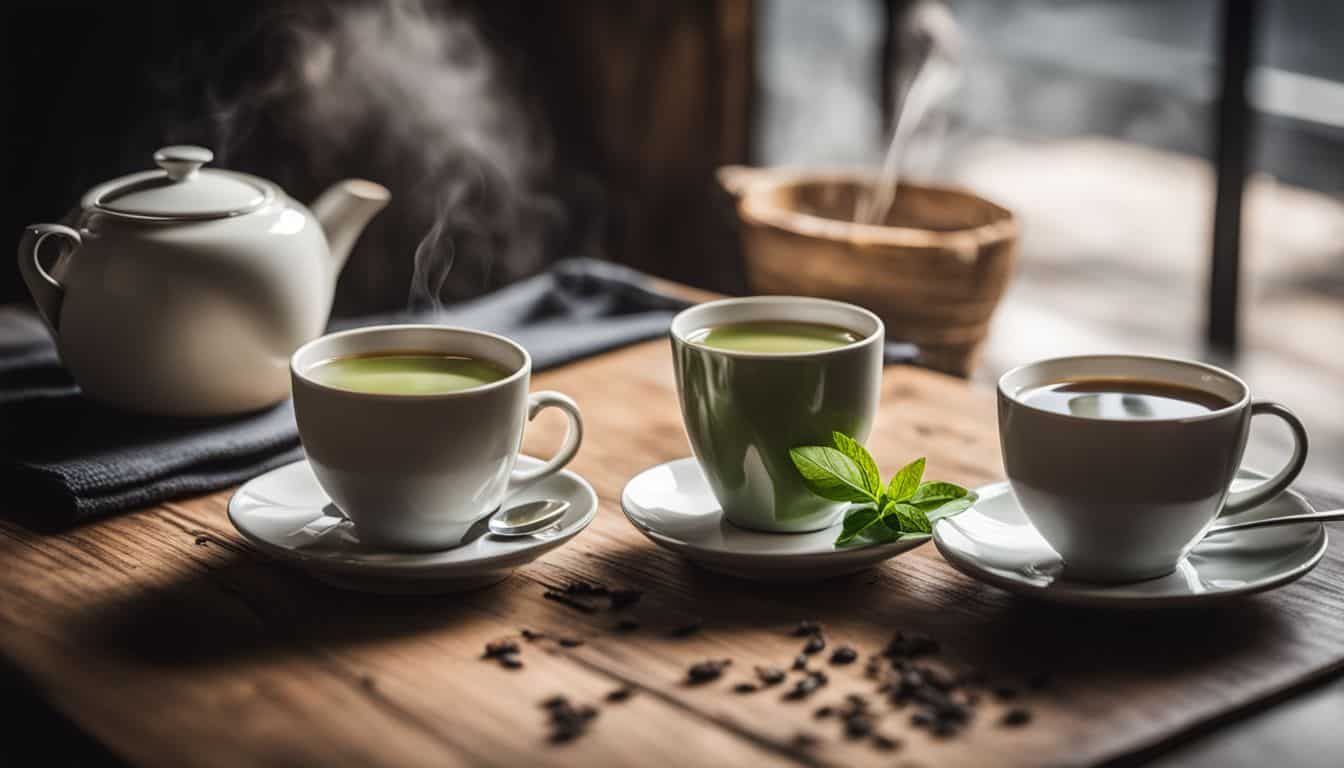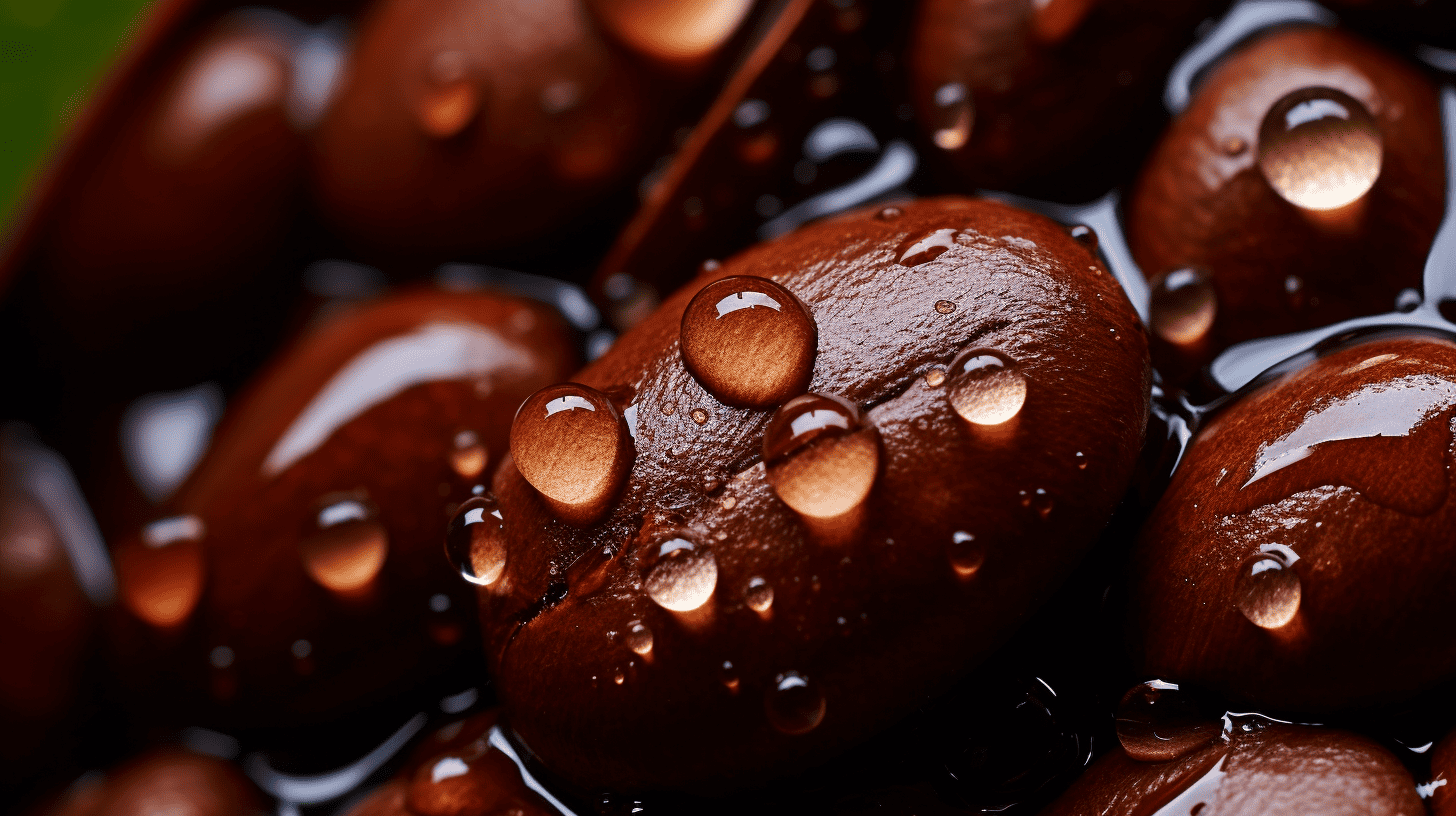From its ancient origins in Ethiopia to the modern-day global obsession, this beloved beverage has woven itself into the fabric of countless cultures and transformed our daily lives.
This blog will take you through the history, reviewing coffee knowledge, various brewing methods, cultural impact, health benefits (and risks!), and ethical considerations surrounding coffee.
So grab your favorite cup of java and join us as we explore everything there is to know about this magical drink that unites people worldwide.
Key Takeaways
Key Takeaways:
- Coffee has a rich and diverse history dates back to ancient Ethiopia, with many cultural traditions and ceremonies still practiced today worldwide.
- Various coffee and brewing methods are available, including espresso, drip coffee, pour-over, French press, specialty drinks like lattes and cappuccinos, cold brew, and iced coffee.
- Coffee shops have become hubs for socialization, offering unique atmospheres and experiences ranging from cozy cafes to modern spaces while providing opportunities for making new friends or enjoying time with old ones.
- Alongside its delicious taste profile, coffee also provides potential health benefits such as increased alertness by stimulating the brain’s activity levels and many other essential nutrients, which can contribute positively to our overall well-being when consumed in moderation.
The Story Of Coffee
Coffee’s origin can be traced back to the ancient coffee forests on the Ethiopian plateau, where legend says a goat herder named Kaldi discovered that his goats became energetic after eating coffee cherries.
The Legend And Origin Of Coffee
Legend has it that the origin of coffee can be traced back to the ancient forests on the Ethiopian plateau. One famous story revolves around a young goat herder named Kaldi, who noticed his goats would become energized and even dance after consuming red berries from a mysterious plant.
Intrigued by this discovery, Kaldi decided to try these berries himself and was amazed by the burst of energy he experienced.
At first, some monks were skeptical about these berries’ magical powers. However, as they began to use them as an ingredient in their daily rituals – grinding them into powder and mixing them with hot water – word started spreading throughout Ethiopia about this invigorating brew called “coffee.” The legend of coffee soon reached far beyond its birthplace on the Ethiopian plateau; merchants traveling to Turkey caught wind of it and introduced these potent beans into Europe during the 16th and 17th centuries.
The Spread Of Coffee To Europe And America
Coffee’s popularity rapidly spread to Europe in the 16th century, with the first coffeehouse established in Venice around 1645. Coffee became a fashionable drink amongst aristocrats and intellectuals, quickly spreading throughout Europe.
By the end of that century, nearly every major European city had a coffeehouse where people could gather to discuss politics and culture. The British even went so far as to create an iconic coffee ritual known as “Afternoon Tea.” In America, coffeehouses popped up along the East Coast after being introduced by colonists from England who were already accustomed to their love for caffeine.
The Industrialization And Globalization Of Coffee
As coffee began to gain popularity in Europe and America, it became clear that there was a significant demand for the beverage. This led to the industrialization of coffee production, with large-scale farms using machines for planting, harvesting, and processing beans.
Significant corporations dominate much of the coffee industry today, controlling everything from farming practices to retail establishments. However, in recent years, small-batch artisanal roasters that focus on creating unique flavors based on specific regions or growing conditions have emerged.
These roasters often emphasize fair trade practices while remaining competitive within an increasingly crowded marketplace.
Types Of Coffee And Brewing Methods
There are various types of coffee, including espresso, drip coffee, pour-over, French press, and specialty drinks like latte, cappuccino, and macchiato.
Espresso, Drip Coffee, Pour-over, French Press
Regarding brewing coffee, several methods produce vastly different tastes and textures. Espresso is a concentrated shot of coffee extracted under high pressure, creating a creamy and bold flavor.
Drip coffee is made by pouring hot water over ground beans in a filter basket, allowing the brew to drip into a carafe below. This method produces a smooth and mild flavor suitable for everyday drinking.
Pour-over involves slowly pouring hot water over the grounds in a cone-shaped filter, producing more robust flavors with clarity and complexity. Finally, the French press steeps coarse grounds in hot water for several minutes before pushing down on the plunger to separate the liquid from the sediment.
Espresso may take some practice to perfect as it requires an expensive machine or special equipment like moka pots, but its boldness makes up for this effort. It’s easy to make drip coffee at home using simple tools like paper or reusable metal mesh filters while consistently achieving outstanding results!
Pour-over method allows you to enjoy nuanced flavors adding elegant touch; many people claim that pour-over is simply one of the best ways to have their morning cup of joe because of its delicate taste offering various layers of aromas depending on your preferences.
Specialty Drinks: Latte, Cappuccino, Macchiato, Etc.
When it comes to specialty coffee drinks, a variety of options are available. A latte, for example, is made with espresso and steamed milk, while a cappuccino has equal parts espresso, steamed milk, and foam.
A macchiato features a shot of espresso with a dollop of frothed milk on top.
Part of the appeal of specialty drinks is their versatility – they can be customized to taste by adjusting the amount or type of ingredients used. For example, some people prefer almond or oat milk lattes instead of regular cow’s milk.
Cold Brew And Iced Coffee
A hot cup of coffee might not be the most refreshing option when it’s hot outside. This is where cold brew and iced coffee come in. Cold brew is soaking coarsely ground coffee beans in cold water for an extended period. Usually, 12-24 hours, resulting in a smooth and less acidic flavor profile than regular drip coffee.
Both types of drinks have gained popularity recently due to their versatility and convenience. They can be customized with milk or cream and flavored syrups to create unique beverages that suit individual preferences.
The Culture Of Coffee
People worldwide have developed a rich and diverse coffee culture, including traditional coffee ceremonies, unique brewing methods, popular drinks like lattes and cappuccinos, and the socialization that often accompanies coffee consumption.
Traditional Coffee Ceremonies Around The World
One of the many fascinating things about coffee is that it is not just a drink but also has cultural significance. In many countries, coffee is essential to important rituals and ceremonies. Here are some traditional coffee ceremonies from around the world:
- Ethiopia – In Ethiopia, coffee ceremonies are central to cultural life. The ritual involves roasting green coffee beans, grinding them by hand, and brewing the coffee in a traditional clay pot called a jebena. The host will serve three rounds of coffee to their guests, with each cup representing different themes: “Abol,” which means “life”; “Tona,” which means “hope”; and “Baraka,” which means “blessings.”
- Turkey – Turkish coffee is famous worldwide for its strong flavor and unique style of preparation. The ceremony involves boiling finely ground coffee beans in water with sugar using a small copper pot called a cezve. Once brewed, the coffee is served in tiny cups and a glass of water to cleanse the palate.
- Japan – In Japan, there is a particular way of making and serving coffee called siphon brewing or vacuum pot brewing. The method involves using two glass chambers connected by a tube. Water boils in one chamber while ground coffee steeps in another before being sucked through the filter into the upper chamber.
- Saudi Arabia – In Saudi Arabia, where hospitality plays a vital role in society, traditional Arabic coffee is served during formal occasions like weddings or business meetings. The host will pour small cups of cardamom-flavored Arabic Qahwa (coffee) from a dallah (a metal pot) into small cups without handles (finjaan).
- Italy – Although Italy doesn’t have any formal ceremonies related to drinking espresso, it’s still considered part of Italian culture thanks to places like cafes where people socialize over their favorite espresso drinks.
Whether traveling or enjoying a cup at home, discovering coffee’s different cultural traditions is an exciting way to immerse yourself in new experiences and learn about other cultures.
Popular Coffee Drinks And Coffee Shops
As a coffee lover, I can’t help but get excited about the different types of coffee drinks out there and the unique coffee shops that serve them.
From classic lattes to innovative creations like nitro cold brew, there’s always something new to try. One popular drink is the cappuccino – a perfect balance of espresso, steamed milk, and foam.
Coffee shops themselves are also part of what makes drinking coffee so unique. Each shop has its vibe and personality, from cozy cafes in small towns to sleek modern spaces in busy cities.
In Italy, for example, you’ll find tiny cafes where people stand at the bar and gulp their espresso before going on with their day.
The Socialization Of Coffee
For many of us, coffee isn’t just a drink; it’s an essential part of our social life. Whether grabbing a quick java on the go or settling in for a long conversation over cappuccinos, coffee shops have become hubs for meeting friends and making new ones.
But coffee’s social impact goes beyond the walls of cafes. In many cultures, drinking coffee is an essential ritual in daily life and tradition. For example, Ethiopian communities hold beautiful cultural ceremonies while sharing cups of traditional coffee made from freshly roasted beans. These customs can help develop relationships with family members and guests alike.
Health Benefits And Risks Of Coffee
Drinking coffee has several potential health benefits, including reducing the risk of type 2 diabetes, liver disease, and depression; however, excessive consumption can lead to jitters, insomnia, and addiction.
Boosts Energy And Productivity
One of the main reasons people turn to coffee in the morning is its ability to boost energy and productivity. This is due to the caffeine content in coffee, which stimulates the central nervous system and can help improve mental alertness and concentration.
Studies have shown that moderate consumption of coffee (around 2-4 cups per day) can lead to improved cognitive function, memory retention, and overall productivity. However, it’s important not to overdo it with too much caffeine, as excessive intake may lead to adverse side effects such as restlessness or insomnia. Learn more about coffee calories here.
Reduces The Risk Of Some Diseases
As a coffee lover, I always wondered whether my caffeine addiction was good for my body. It turns out coffee can help reduce the risk of some diseases! Studies have shown that regular coffee consumption can lower the risk of developing type 2 diabetes, liver cancer, and Parkinson’s disease.
In addition to reducing the risk of certain diseases, moderate coffee intake has also been linked with a decreased risk of heart failure and stroke. However, it is essential to note that excessive caffeine intake can lead to adverse side effects such as increased anxiety levels and disrupted sleep patterns.
Potential Negative Effects (jitters, Addiction)
As much as we love coffee, it’s essential to acknowledge its potential adverse effects. Consuming too much caffeine can lead to jitters that may negatively affect your productivity and overall well-being.
Additionally, long-term consumption of coffee may lead to addiction, which creates a dependency on the drug. Fortunately, there are ways to prevent these adverse effects while still enjoying the benefits of coffee.
For instance, you can manage your caffeine intake by drinking your last cup early in the afternoon or switching to decaf towards bedtime.
Sustainability And Ethics In The Coffee Industry
Coffee consumers can play a role in promoting sustainability and ethical practices by choosing to purchase beans that are certified Fairtrade, organic, or sourced through direct trade methods.
Fairtrade, Organic, And Direct Trade Practices
As coffee continues to be a global commodity, more and more attention is being given to the ethical considerations involved in its production and distribution. Fairtrade practices ensure that farmers receive fair compensation for their labor and products.
Organic farming methods help reduce harm to the environment and those who produce or consume coffee.
For example, I recently visited a small coffee farm in Nicaragua that utilized these practices. The farmer showed me how they carefully process their beans using organic methods, ensuring the highest quality products.
Overall, understanding the impact of our choices as consumers can make all the difference in promoting sustainability in the coffee industry.
Environmental Impact Of Coffee Production
As much as coffee is loved by millions worldwide, the production of coffee often has negative environmental impacts. Cultivating, harvesting, and processing coffee beans can lead to deforestation, soil erosion, and water pollution.
However, not all hope is lost. Many sustainable farming practices have emerged over recent years that aim to reduce these harmful environmental effects.
For example, shade-grown coffee uses trees instead of artificial structures for shade while providing a habitat for birds and other animals. Fairtrade-certified coffees support farmers who use eco-friendly methods while protecting their workers’ rights.
Ethical Considerations
As a coffee lover, I am aware of the ethical considerations that come with consuming coffee. The global demand for coffee has been linked to child labor, low wages, and poor working conditions for farmers.
One way to do this is by choosing Fairtrade or direct trade coffees that ensure fair compensation for farmers and their workers. Additionally, opt for organic coffees grown without harmful pesticides and chemicals that can harm both people and the environment.
As consumers, we can make conscious choices about what we consume and whom we support in the coffee industry.
Conclusion
Final thoughts, coffee is much more than just a beverage. Its rich history, unique varieties, and diverse brewing methods make it an integral part of cultures around the world.
From traditional coffee ceremonies to modern coffee shops, this drink has brought people together for centuries. Additionally, with its potential health benefits and ethical considerations in the industry, there are many reasons to appreciate and explore all that coffee has to offer.
FAQs on Coffee Knowledge:
1. What is the history of coffee, and how did it become so popular worldwide?
Coffee originated in Ethiopia and was first consumed by Arabians who used it for medicinal purposes. It gradually spread globally, with different cultures developing unique brewing methods and traditions.
2. What are some health benefits associated with drinking coffee?
Coffee contains antioxidants that can help reduce inflammation and lower your risk of chronic diseases such as diabetes, heart disease, and certain types of cancer. Moderate caffeine intake has also been shown to enhance cognitive function and boost mood.
3. How do different brewing methods affect the taste of coffee?
Different brewing techniques can bring out distinct flavors in coffee beans based on water temperature, grind size, steeping time, and pressure. For example, the French press tends to produce a full-bodied brew with a more robust flavor profile, whereas pour-over results in a clean cup with subtle nuances.
4. How does coffee culture vary around the world?
Coffee culture varies greatly depending on geography, tradition & social customs but typically revolves around shared experiences over cups of brewed beverages. Most American cafés tend to offer quick takeaway options or drive-thru windows, while European countries often enjoy more leisurely moments sitting outside at tables chatting while sipping cappuccino – either way – Coffee plays an important role worldwide when bringing people together into comfortable settings where they can share ideas or catch up on life events happening beyond screens & keyboards!





Leave a Reply